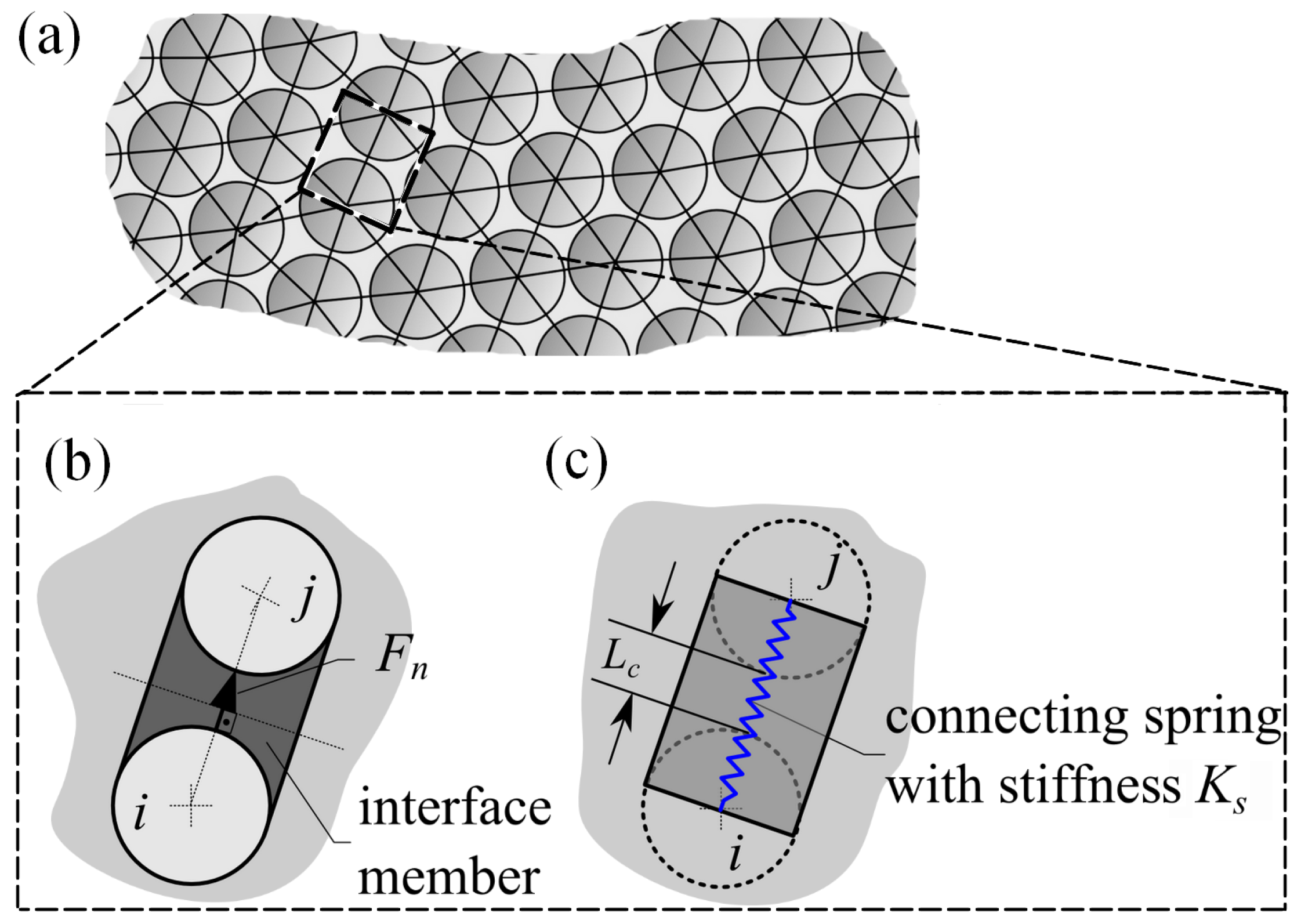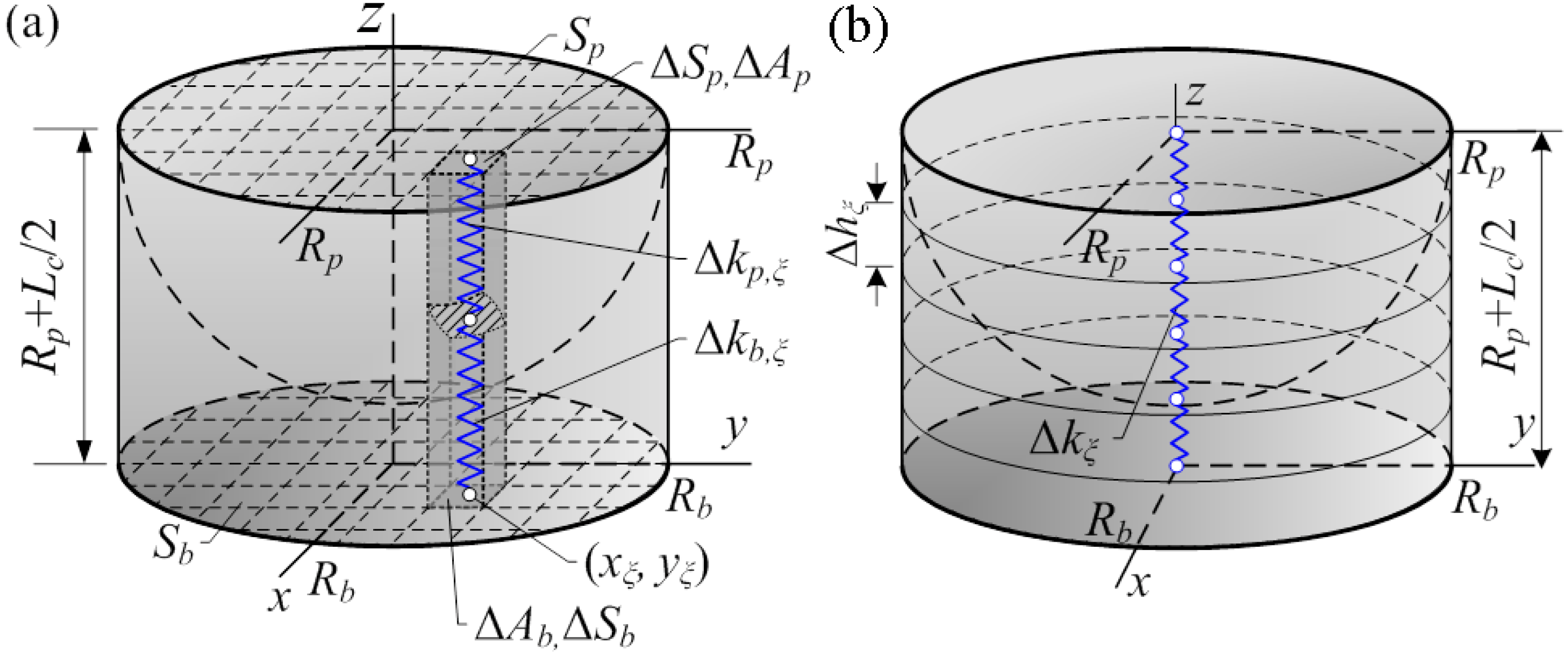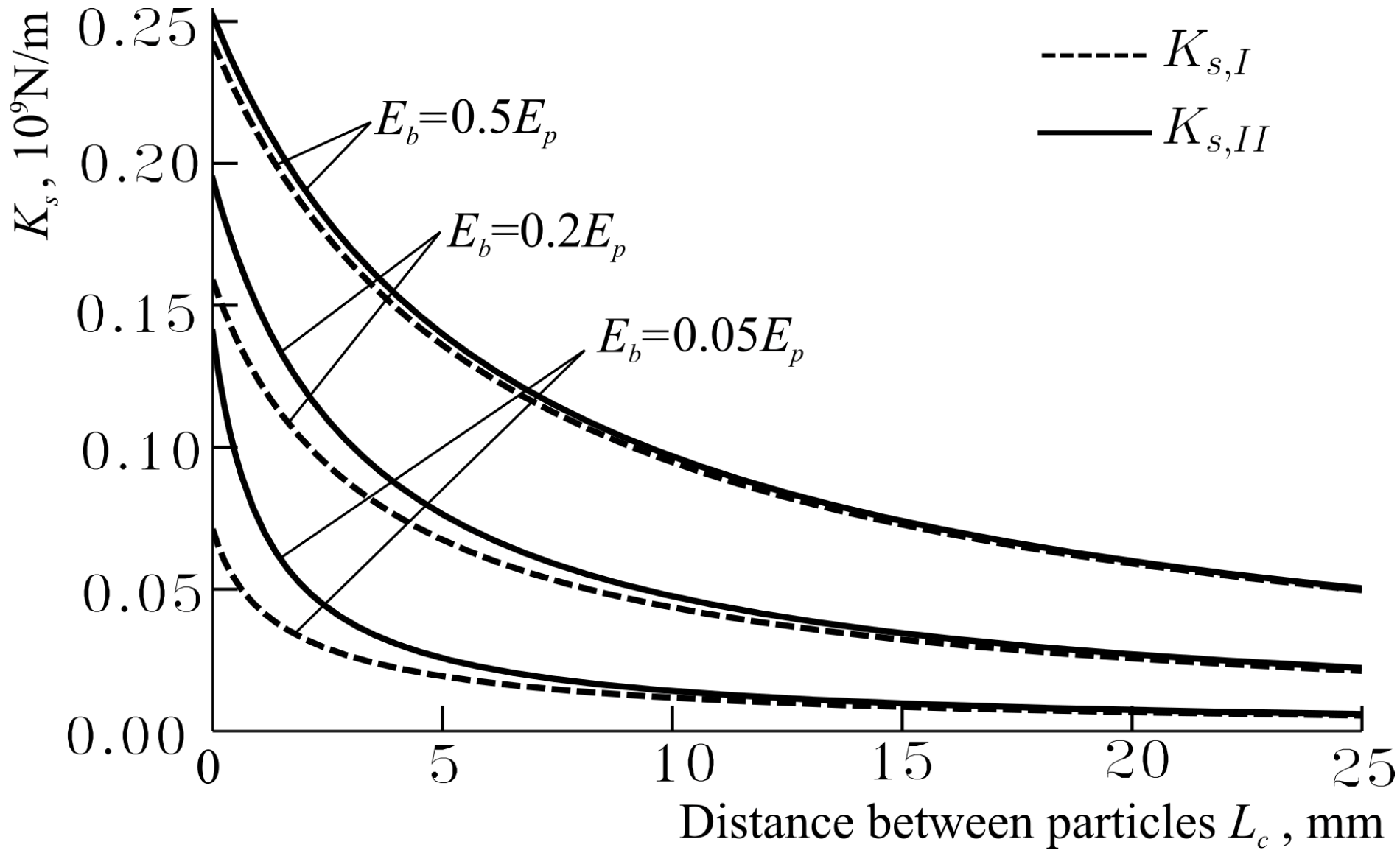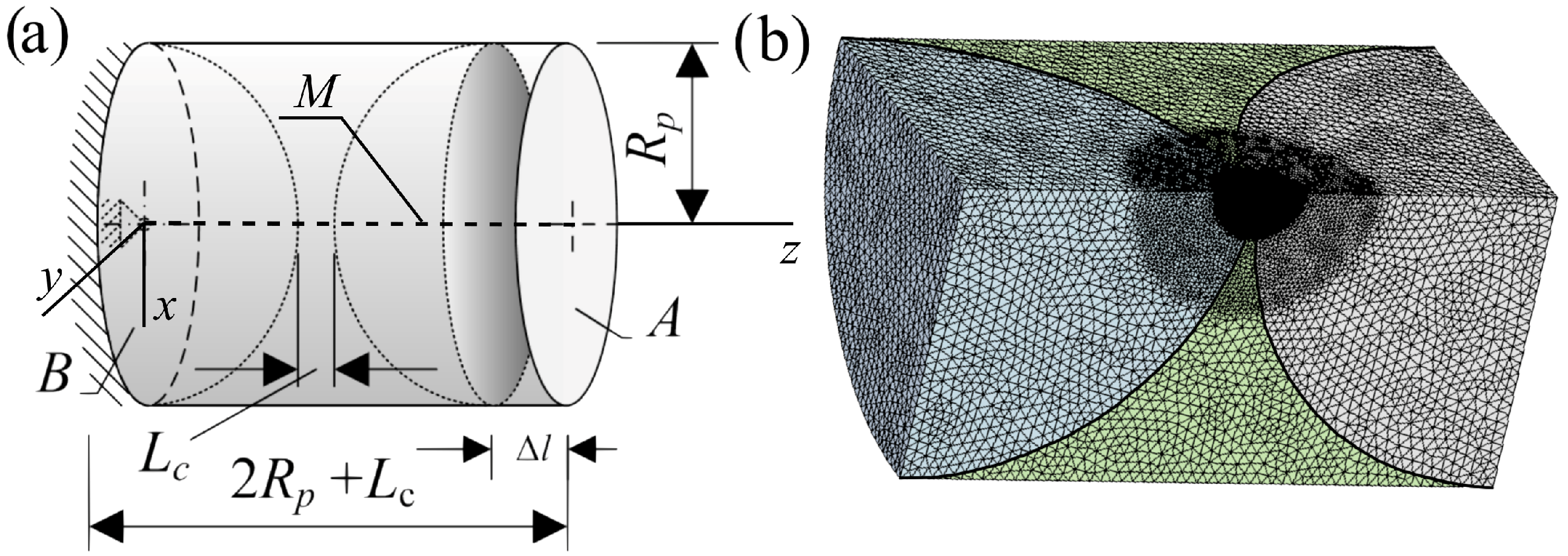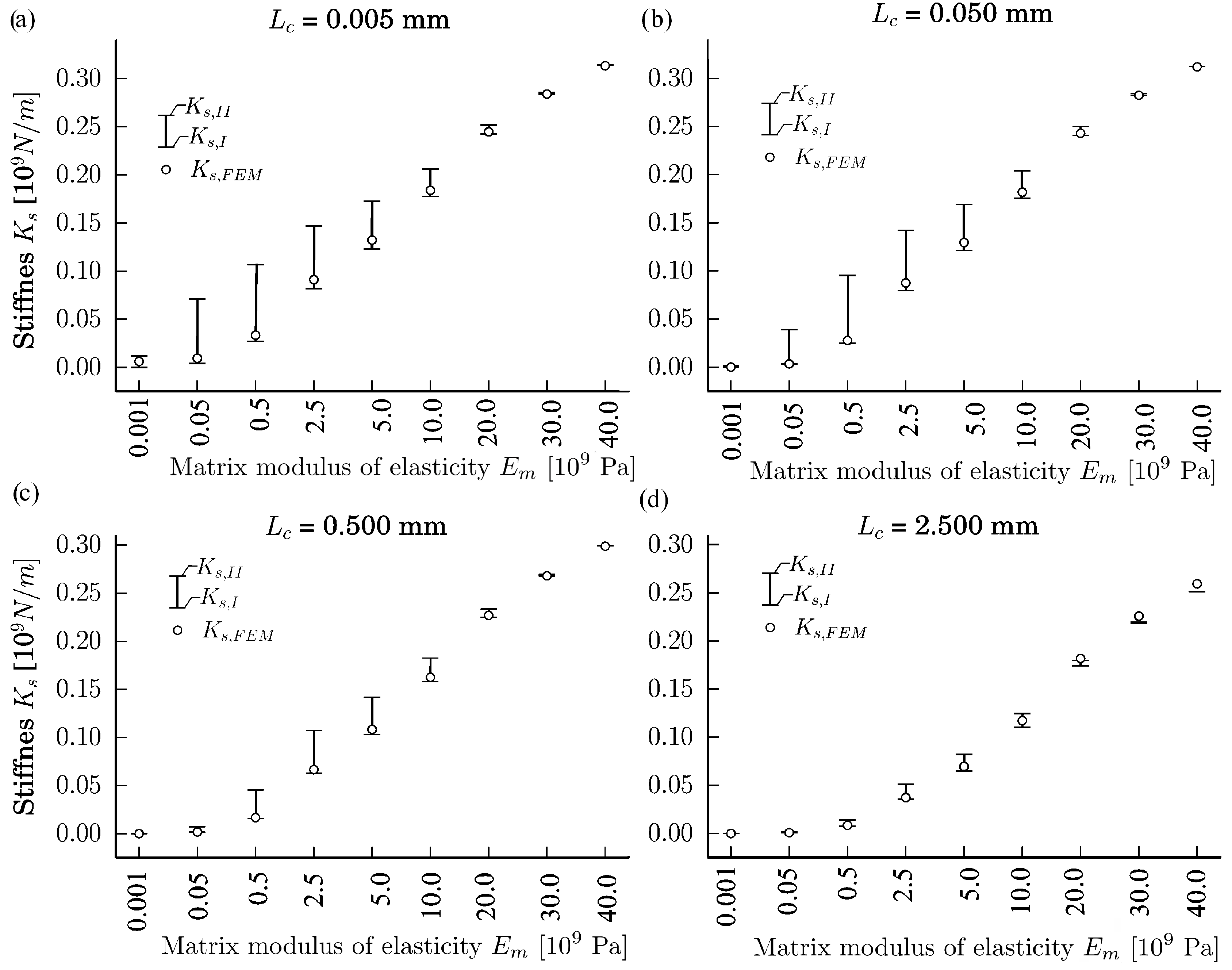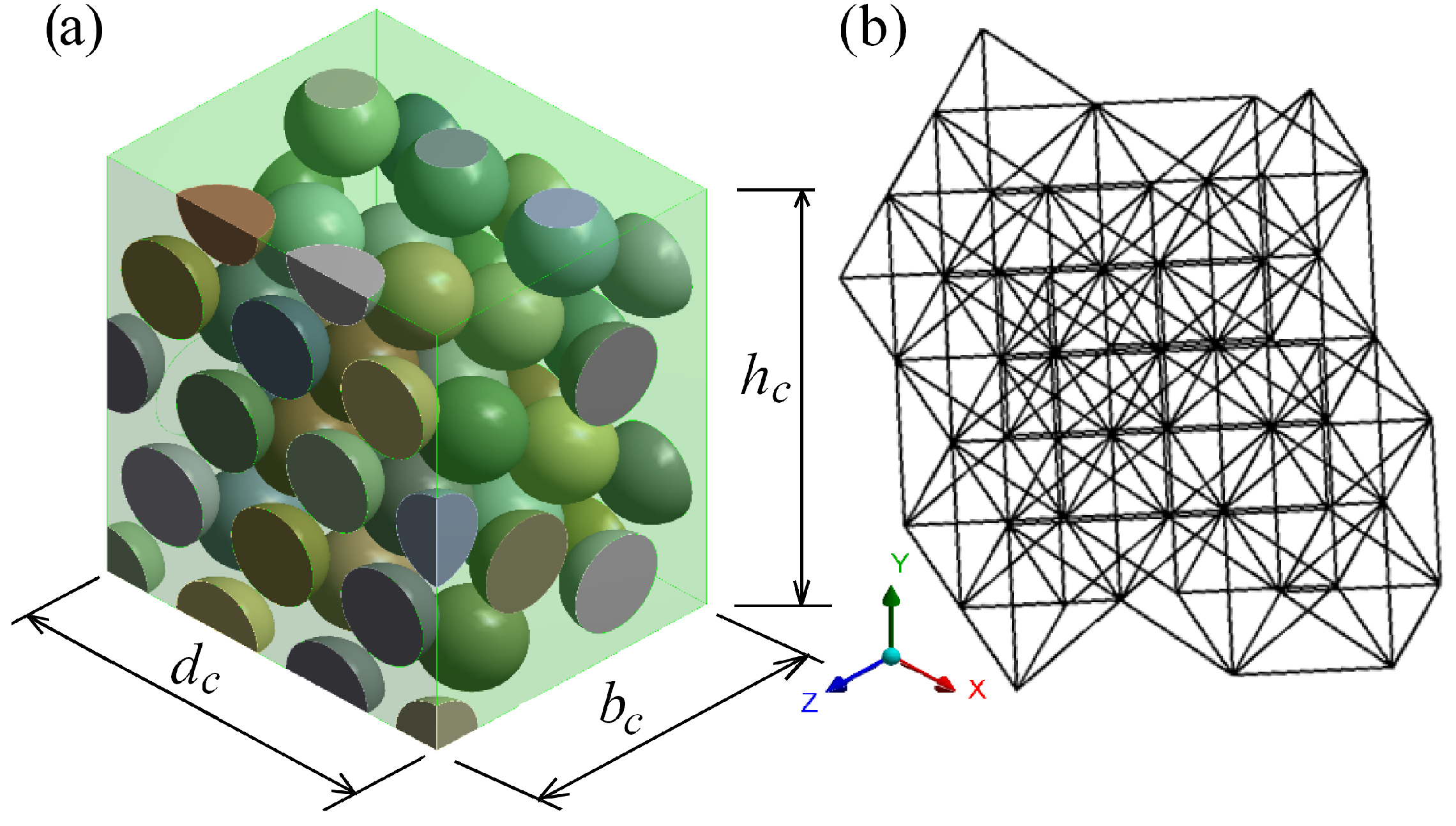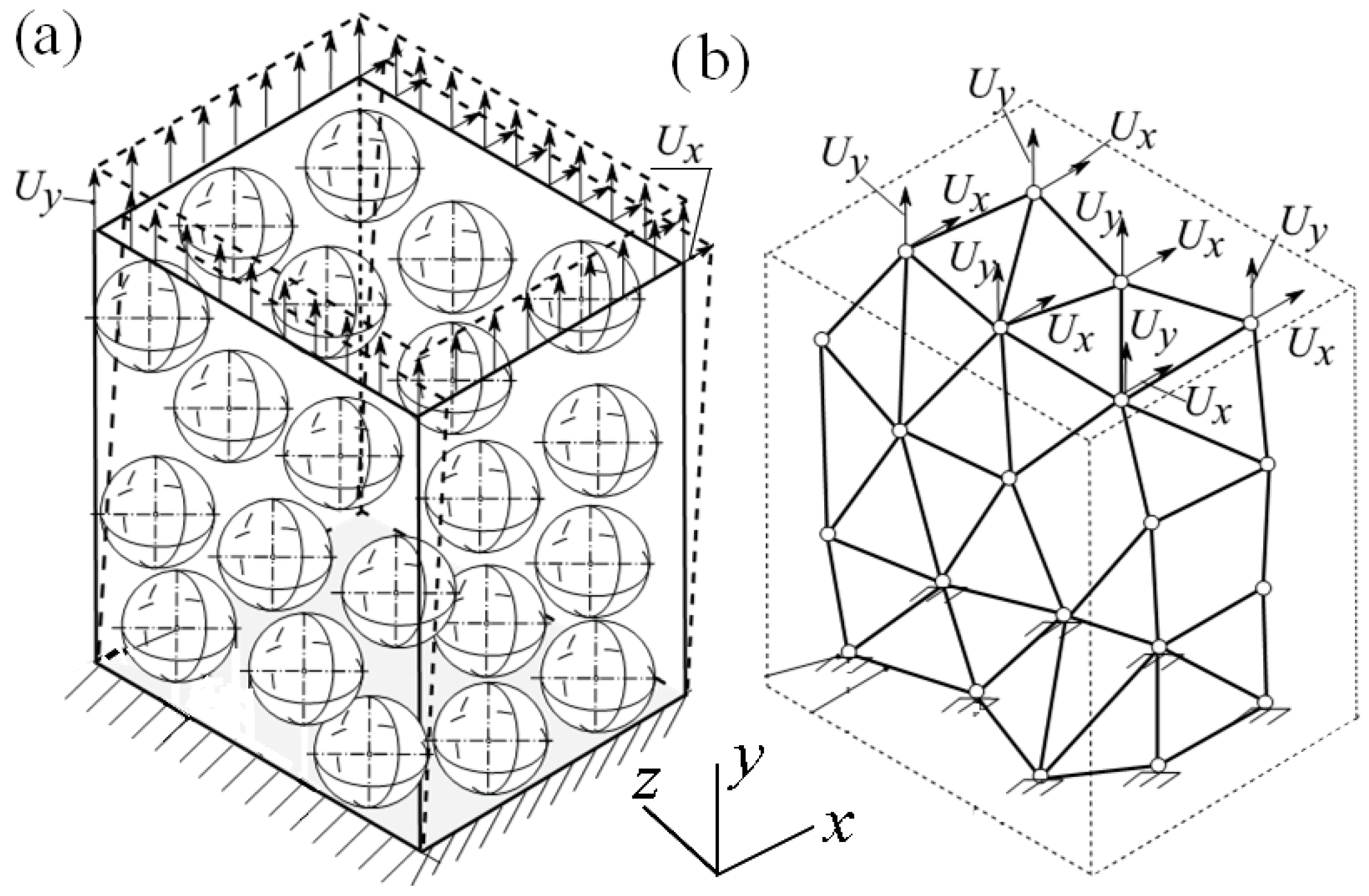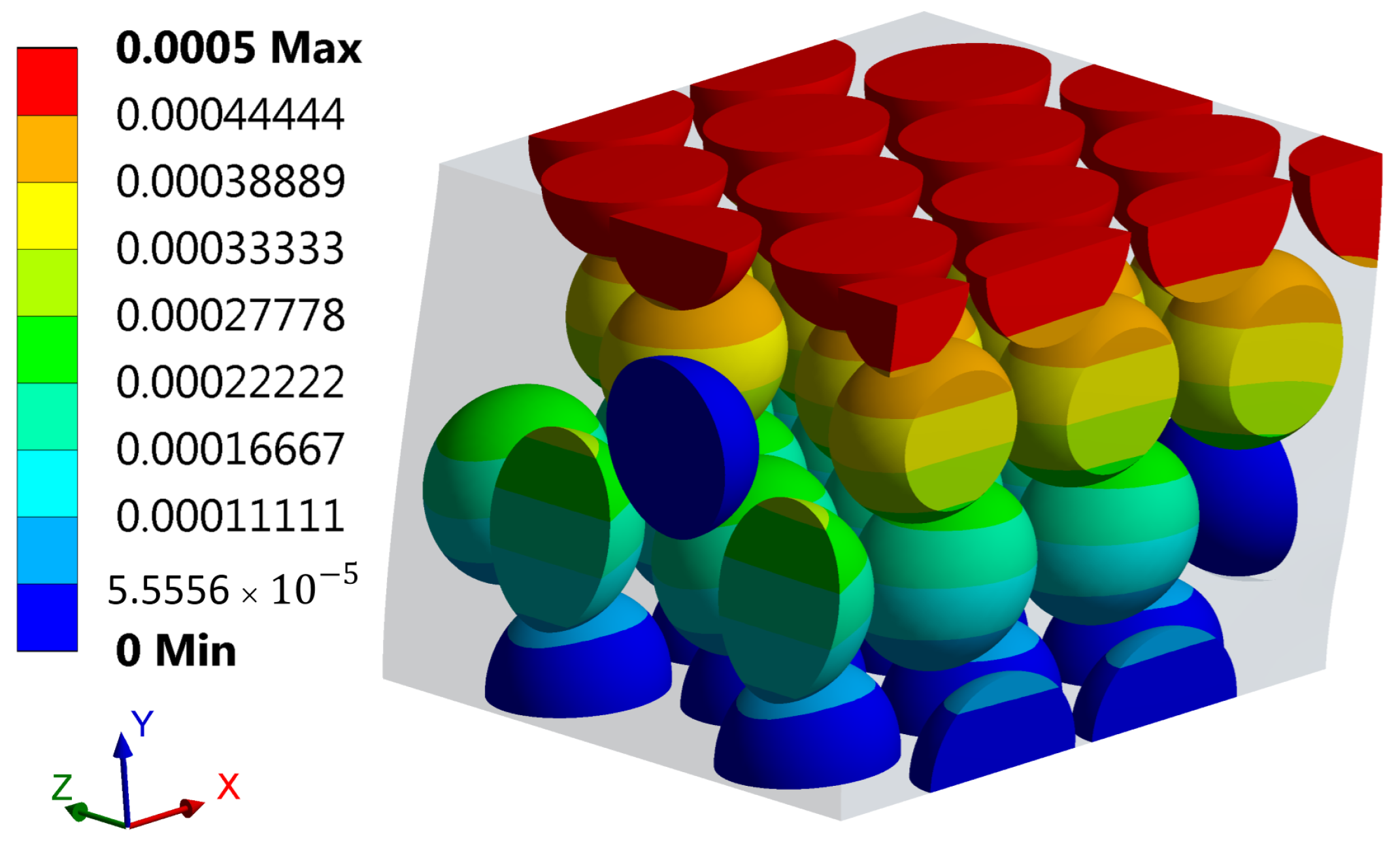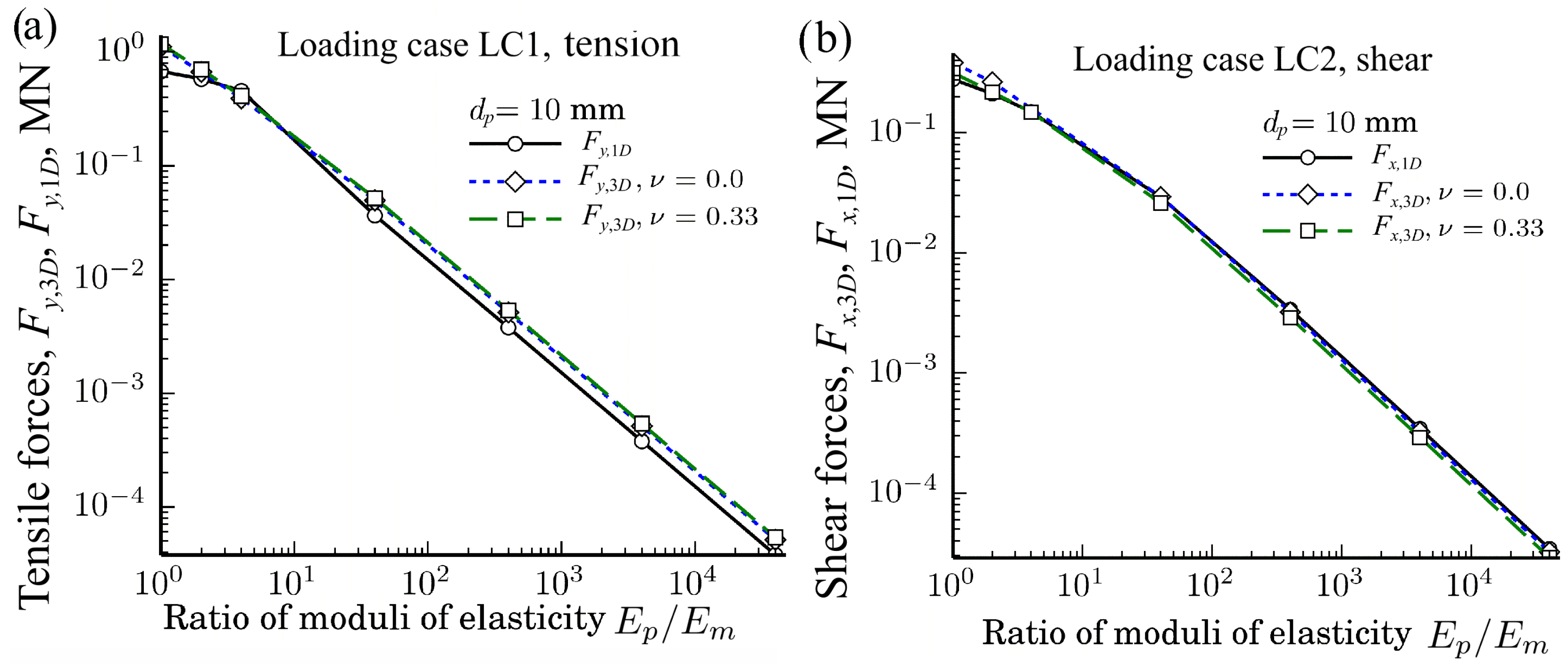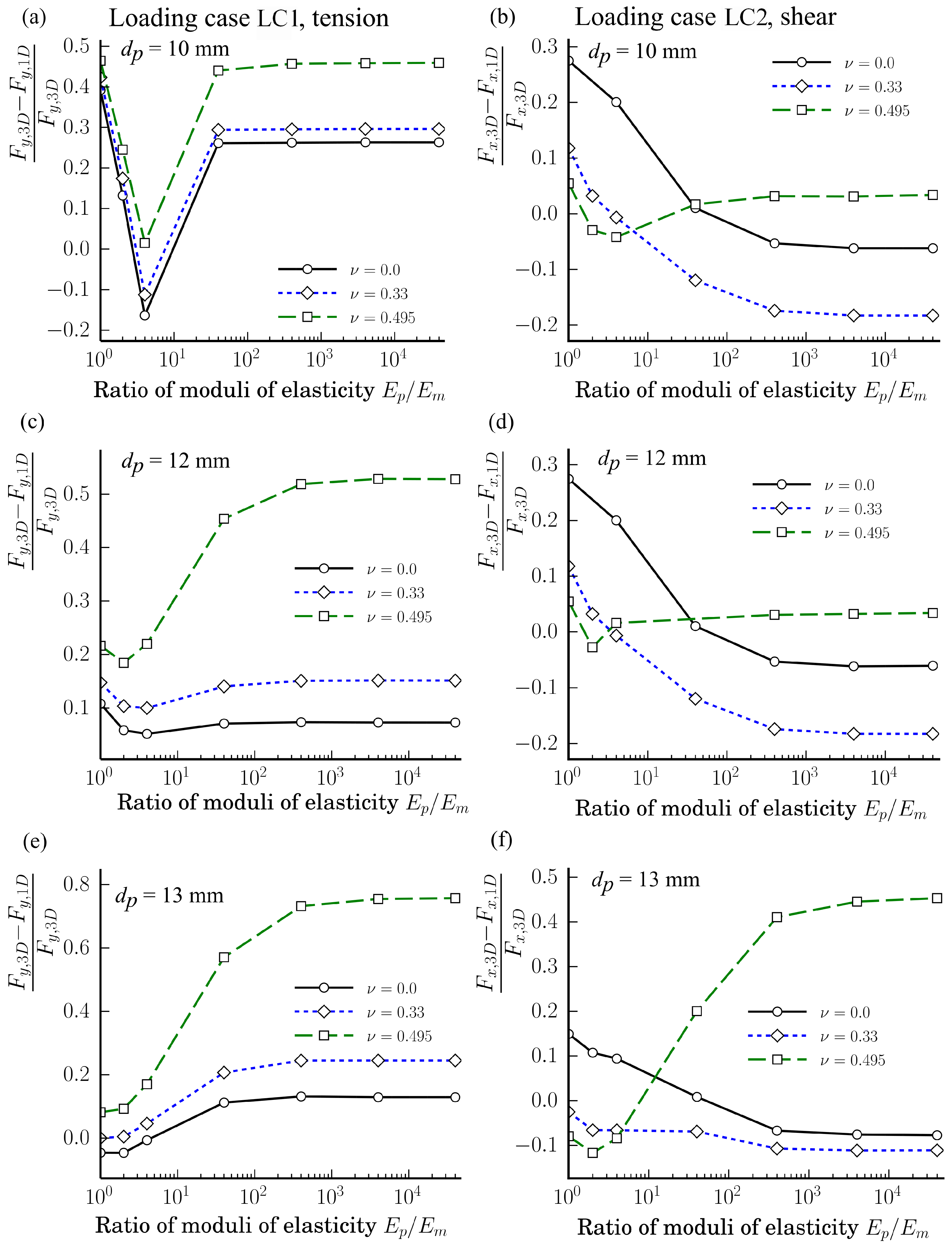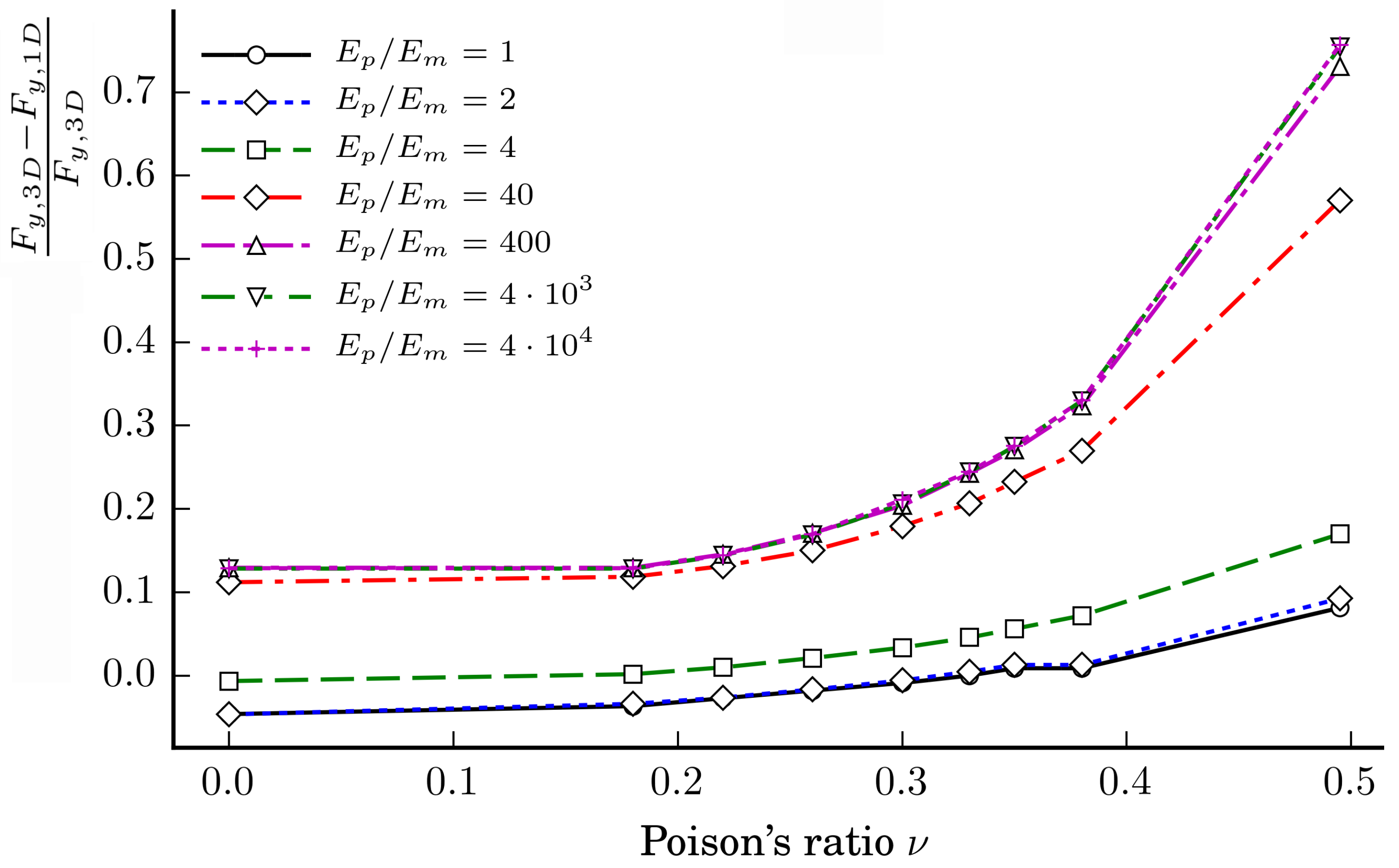Two numerical validations of the proposed methodology are presented hereafter in two subsections. In the first validation, the stiffnesses and are compared with the stiffnesses of the 3D FE models of the connecting elements. In the second one, the mechanical behaviour of the particulate composite cube approximated by the spring model (SM) and modelled by 3D FE is compared. The FE analysis was performed by ANSYS 12.
2.1. Stiffness of the Connecting Element
The obtained Equations (
9), (
10) and (
19) of the stiffnesses
and
were verified by a 3D FE analysis of the connecting element shown in
Figure 4. Two cases were considered. In the first case,
GPa,
,
Pa,
. In the second case,
GPa,
,
Pa,
. For both cases,
m, and
m. These parameters of the particles and interface member were chosen so that it would be possible to verify the obtained equations at different moduli of elasticity
, Poisson’s ratios
, and at the different distances between the surfaces of the particles
.
The sample under investigation and its FE model, a quarter of the sample consisting of
nodes and
elements, with mesh are depicted in
Figure 4a,b, respectively. The boundary conditions were as follows:
was applied to plane
B, and
was applied to the centre line
M (
Figure 4a, dotted line) of the FE model. The FE model was discretised by the tetrahedron elements “SOLID187” of 10 nodes of six degrees of freedom (
Figure 4). The average size of the finite elements of the particles of the sample was
. The volume of the interface material was conditionally divided into two regions. The contact region between spheres was meshed by fine mesh whose average size of the finite elements was
, while the remaining volume was meshed by a coarser mesh of an average size
(
Figure 4b).
The stiffness obtained by the FE method, denoted hereafter as
, was obtained by applying a displacement
on free plane
A (
Figure 4a) and was calculated as
, where
F is the total reaction force of plane
B at the displacement
.
The calculation results are shown in
Figure 5. As we can see from
Figure 5, when
, then, in the majority of the examined cases,
is closer to
than to
, i.e.,
. However, when
and
then
is closer to
than to
. In addition, from
Figure 5, we can see that in the majority of cases, except from the case when
and
, the stiffness
. In
Figure 5, it is clearly depicted that
when
.
2.2. Mechanical Behaviour of a Particulate Composite Cube
The developed SM was validated by comparing the mechanical responses of a 3D particulate composite (see
Figure 6) obtained by the 3D FE method and by SM. The stiffness of the springs of SM was calculated by the developed formulas given in Equations (
9) and (
10).
Overall, 126 samples, which differ in the modulus of elasticity of matrix
and the volume fraction of the particles
, were calculated. The properties of the 3D FE model and the SM are the following (see
Figure 6): the diameters of the particles
mm and the corresponding volume fractions of the particles
%; the dimensions of the cube are (see
Figure 6): height
mm, width
mm and depth
mm. The moduli of elasticity of the 3D FE model and the springs of the SM are the following:
Pa for the matrix, and
Pa for the particles. Poisson’s ratio of the particles and matrix for the 3D FE model are
, and the Poisson’s ratios for the particle and matrix are the same, i.e.,
. The stiffnesses of the springs were calculated by Equations (
9) and (
10). The elastic constants of the springs for SM were taken as for the uniaxial stress state, i.e.,
,
. Therefore, Poisson’s ratio does not affect the stiffnesses
of the springs. The length of the connecting elements
and the distance between the particles
of the samples depend on the volume fraction
:
mm for
(
mm),
mm for
(
mm) and
mm for
(
mm). It is determined that the stiffness
is closer to
than to
as
is small enough. Therefore, the results calculated only with the stiffness
are presented hereafter. The 3D FE model and SM of the composite consist of tetrahedron lattices.
To validate the proposed methodology, the vertical
and horizontal
displacements in the directions
y and
x were imposed to the top planes of the corresponding samples, see
Figure 7, and the tensile
and shear
forces of the 3D FE model were compared with the corresponding tensile
and shear
forces of the FE model of SM. The boundary conditions for the 3D FE model and SM were as follows: the displacements of the bottom plane of the 3D FE model and SM were restricted fully, i.e.,
, see
Figure 7.
Two loading cases were applied to the specimens to validate the proposed methodology, see
Table 1.
For the sake of illustration, the shear displacements
of the 3D FE model in the direction
x subject to loading case LC2 are shown in
Figure 8.
The dependences of the tensile and shear forces
,
,
, and
, of the loading cases LC1 and LC2 on the ratio
calculated by the 3D FE method and by SM, when
mm at different Poisson’s ratios
and different particles diameters
mm in double logarithmic scales, are shown in
Figure 9. It should be noticed that the calculated tensile and shear forces
and
of SM do not depend on Poisson’s ratios
, since the calculations were performed as
,
, i.e.,
does not depend on Poisson’s ratio.
As we can see from
Figure 9, the agreement between the results of
and
as well as between
and
seems very good in double logarithmic scale at various ratios
and
. However, the relative ratios of the forces
and
can reveal the agreement between the results better.
The dependences of the relative ratios
and
of the loading cases LC1 and LC2 on the ratio
at different Poisson’s rations
and particle diameters
in semi-logarithmic scales are shown in
Figure 10. The relative ratios of loading case LC1 are shown in
Figure 10a,c,e while those for the loading case LC1 are shown in
Figure 10b,d,f. The ratios shown in
Figure 10a,b correspond to the case when
mm, whereas, in (c) and (d), to the case when
mm, and in (e) and (f) to the case when
mm.
As we can see from
Figure 10, there is not any unique tendency for the ratios
and
dependent on
except for the fact that the variation of the relative ratios is smaller when
Pa. From
Figure 10, we can also see that for the tension loading case LC1, when
mm, the relative difference
is the biggest as
. However, a similar conclusion is not valid for the shear loading case LC2. Only when
mm and
, the ratio
is the biggest for
. The value of the Poisson ratio 0.495 is an extreme case. It real life, for common materials, the Poisson ratio can be assumed as
. The analysis showed that, for the calculated cases, the following limits are valid as
mm: for the loading case LC1
as
and
as
; while for the loading case LC2
as
, and
as
. Since the width of the intervals of the relative ratios of the loading case LC2 are less than for the loading case LC1, then the proposed methodology is more accurate for LC2 than for LC1.
The dependencies of the relative ratios
of the axial forces of the loading case LC1 on the Poisson ratios
at different ratios
when the particles’ diameter
mm are shown in
Figure 11.
The figure clearly shows that, when mm, the relative ratio increases with increasing the ratio . In addition, the relative ratio increases with increasing the Poisson ratios and of the particles and matrix, respectively. The relative ratio increases relatively slowly within the interval and sharply when .
The obtained relative ratios may be treated as too big; however, the effective mechanical properties have to know to approximate a particulate composite as a homogeneous solid by the springs. This prognosis is always inaccurate due to many factors affecting the properties of a composite that cannot be taken into account in the calculations. For example, the well known Hashin–Shtrikman lower and upper bounds [
14] may also vary within wide intervals.
When Poisson’s ratio
, then the obtained axial forces
of the 3D FE model of the loading case LC1 can be compared with the axial forces
and
of the homogeneous cube whose effective elastic moduli
and
are calculated by Hashin–Shtrikman’s bounds, where
is the cross-section area of the cube. The dimensions of the homogeneous cube are the same as for the 3D FE model shown in
Figure 6. The moduli
and
are calculated by taking into account the volume fractions of the particles
of the 3DFE model:
as
mm,
as
mm, and
as
mm. The analysis has shown that
is closer to
than
to
. It is also determined that the relative ratios
when
or when
mm; however, when
or
mm, then
. Therefore, when the distance between the particles’ surfaces decrease, the efficiency of the proposed methodology increases in comparison to the Hashin–Shtrikman bounds. It should be noted that the already existing methodologies for predicting the effective mechanical properties of composites cannot be applied directly to the lattice model, since the stiffnesses of the connecting element are to be determined. The extra methodology has to be involved in the calculations. These considerations show that the proposed methodology can be useful for predicting the stiffness constants of the connecting element. Moreover, as the analysis showed, the greater the ratio
is, the more accurate is the proposed methodology in comparison to well-known methodologies of the prediction of the effective mechanical properties of the composites due to the fact that the relative ratios
and
,
do not increase very much with increasing the ratio
.
